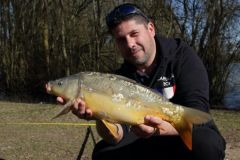Gilthead sea bream are very common from April to late September in Brittany, particularly in my area on the Gulf of Morbihan or in the estuaries. They travel in shoals, sometimes very large, in search of food. On the Gulf, catches of 3 to 4 kg are very common, but it is sometimes very difficult to deceive their distrust and above all to locate them.
A special set of teeth
The sea bream has a very varied diet, feeding on worms, crabs and various shellfish. Its mouth is equipped with molars that enable it to crush crustaceans, mussels and even oysters, making it a real enemy for oyster farmers. Indeed, in the Gulf of Morbihan, a shoal of sea bream can decimate oyster swarms in a matter of days when they move into a concession.

Food items
Good spots for sea bream are those that offer a high food potential and a certain comfort, particularly in areas with strong currents such as the Golfe du Morbihan or the Ria d'Etel. To find them, you'll need to look for gravel and sandy plateaus, dotted with a few rocks sheltering shellfish, crustaceans and molluscs.
The plateaus are not the only spots to prospect, especially from the shore. All the rocky points, covered with mussels and licked by a powerful current, are excellent holding and feeding areas that should be exploited. These rocky points are particularly good, as they create a counter-current that allows dorados to shelter from the current and feed more easily.

Be precise in your prospecting
Whether you're fishing from the shore or from a boat, the key to success is to pinpoint the fish's position. Sea bream move enormously and the absence of bites should lead you to cast in a different direction or to shift the drift of your boat. In the "potholes" or counter-currents created by rocky points, the strategic point is often at the edge of the current and counter-current. Within 10 meters, your outing can take on very different forms.

Identifying the right moments
While the location of the shoal is essential for successful fishing, it's also important to understand the movements of the dorados. Depending on the tide, they will move from one station to another, or shift around the area. So, it's by multiplying your fishing trips that you'll be able to understand their circuit and anticipate their movements. What's more, when an area no longer offers sufficient food interest, they will desert it from one day to the next, forcing you to start prospecting all over again.

A fine, muscular peach
A wary fish, the great difficulty with sea bream lies in hooking. They will "chew" the bait for a long time before completely engamming it, and will regularly clean your hooks without you even having a chance to hook them.
However, if this type of fishing calls for finesse in its application, the equipment will need to be powerful, as bream is a serious fighter and rocky points covered with mussels are particularly dangerous for your line.

Posed or tenya
Although they can be caught accidentally with lures, gilthead bream are best fished with bait. There are two possibilities:
- Land-based fishing for shore and boat anglers.
- Tenya fishing drifting, for on-board fishermen.










